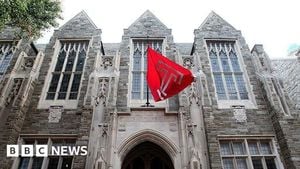Two ambitious infrastructure projects are set to reshape the Dominican Republic's urban and judicial landscapes as they near completion, reflecting the government's commitment to modernization and improved public service.
The Ciudad Judicial, located in Santo Domingo Este, is slated for delivery by the end of February. Deligne Ascención, the Minister of Public Works, announced this timeline as he inspected the project alongside prominent figures such as Luis Henry Molina Peña, president of the Supreme Court of Justice; Miriam Germán, the Attorney General of the Republic; and Rodolfo Valentín Santos, director of the National Office of Public Defense. Ascención noted, "The remaining work is minimal, mostly involving cleaning and the construction of staircases in the central atrium," emphasizing the project's imminent completion.
Molina Peña elaborated on the judicial transformation the Ciudad Judicial will facilitate, describing it as the epicenter of criminal cases within the country. He stated, "This project signifies a major improvement in the administration of justice for the citizens of this region," underscoring its potential impact.
The new judicial complex will adopt innovative features aimed at streamlining legal processes, moving away from traditional paper methods toward more agile and interactive systems among involved institutions. The new facility, the largest and most modern of its kind in Latin America, will house various branches of the justice system, including the Public Ministry and the National Office of Public Defense.
The Ciudad Judicial will encompass 22 hearing rooms, distributed across four levels, and provide comprehensive services with 330 parking spaces. The layout is expansive, totaling 14,250 square meters for the Judicial Power, organized across several interconnected blocks. Notably, the second and third floors will be dedicated to hearing rooms capable of seating between 35 to 80 individuals each.
The project has been certified with a budget of over RD$4.4 billion, reflecting the government’s serious investment in enhancing judicial infrastructure. Santos gave assurance of the project's readiness, indicating active preparations to furnish the building and recruit necessary staff, ensuring fundamental access to justice for all citizens.
Meanwhile, the revitalization of the historic tourist area, Pueblo de los Pescadores, is poised for its grand reopening between February 15 and 20. This rejuvenation follows significant destruction caused by a fire back in September 2021 which devastated at least sixteen businesses. Minister of Tourism David Collado highlighted the impending completion with excitement. "February will mark the realization of the Pueblo de los Pescadores!" he proclaimed on social media.
During inspections of the newly refurbished area, Collado emphasized quality checks to meet tourism standards, ensuring the development aligns with what the region deserves. He assured improvements include state-of-the-art fire safety systems to protect both merchants and visitors alike, indicating a commitment to not only restore but to bolster tourism safety and infrastructure.
Collado described the revitalization as not just cosmetic; it is strategic for the future of tourism and community welfare. He reiterated, "My people, the Pueblo de los Pescadores will be ready this February!" signifying the importance of this project to the local community and tourism at large.
Both projects indicate a strategic approach by the Dominican government to invest in infrastructure development, addressing prior deficiencies and enhancing public facilities for the upcoming years. With the Ciudad Judicial focusing on justice reform and Pueblo de los Pescadores aiming to recover and boost tourism, these initiatives collectively promote growth and community development throughout the country.
With these developments nearing completion, citizens can look forward to significant enhancements to judicial processes and tourism experiences, potentially revolutionizing how services are delivered. The efforts by the government showcase not only the infrastructural improvements but also reflect broader aims of social reform and economic upliftment.



